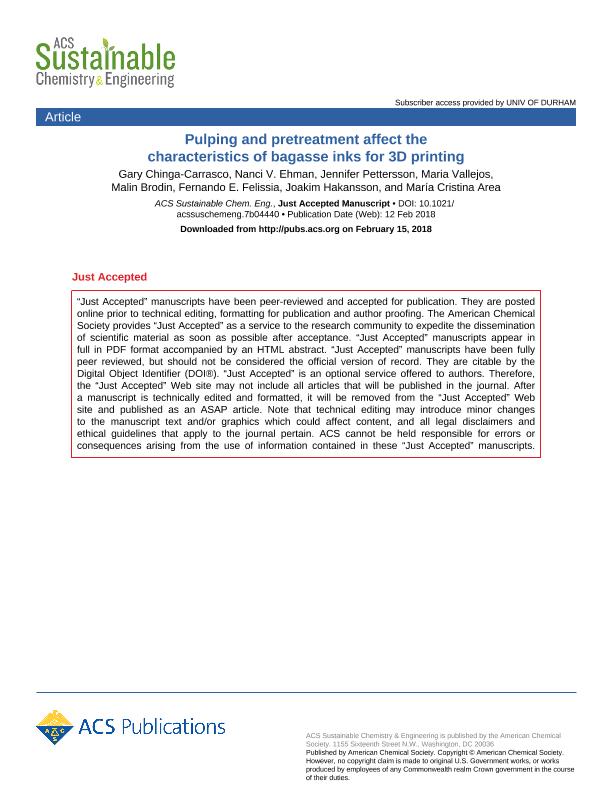Artículo
Pulping and pretreatment affect the characteristics of bagasse inks for 3D printing
Chinga Carrasco, Gary; Ehman, Nanci Vanesa ; Pettersson, Jennifer; Vallejos, María Evangelina
; Pettersson, Jennifer; Vallejos, María Evangelina ; Felissia, Fernando Esteban; Hakansson, Joakim; Area, Maria Cristina
; Felissia, Fernando Esteban; Hakansson, Joakim; Area, Maria Cristina
 ; Pettersson, Jennifer; Vallejos, María Evangelina
; Pettersson, Jennifer; Vallejos, María Evangelina ; Felissia, Fernando Esteban; Hakansson, Joakim; Area, Maria Cristina
; Felissia, Fernando Esteban; Hakansson, Joakim; Area, Maria Cristina
Fecha de publicación:
03/2018
Editorial:
American Chemical Society
Revista:
ACS Sustainable Chemistry and Engineering
ISSN:
2168-0485
Idioma:
Inglés
Tipo de recurso:
Artículo publicado
Clasificación temática:
Resumen
Bagasse is an underutilized agro-industrial residue with great potential as raw material for the production of cellulose nanofibrils (CNF) for a range of applications. In this study, we have assessed the suitability of bagasse for production of CNF for three-dimensional (3D) printing. First, pulp fibers were obtained from the bagasse raw material using two fractionation methods, i.e. soda and hydrothermal treatment combined with soda. Second, the pulp fibers were pretreated by TEMPO-mediated oxidation using two levels of oxidation for comparison purposes. Finally, the CNF were characterized in detail and assessed as inks for 3D printing. The results show that CNF produced from fibers obtained by hydrothermal and soda pulping were less nanofibrillated than the corresponding material produced by soda pulping. However, the CNF sample obtained from soda pulp was cytotoxic, apparently due to a larger content of silica particles. All the CNF materials were 3D printable. We conclude that the noncytotoxic CNF produced from hydrothermally and soda treated pulp can potentially be used as inks for 3D printing of biomedical devices.
Archivos asociados
Licencia
Identificadores
Colecciones
Articulos(IMAM)
Articulos de INST.DE MATERIALES DE MISIONES
Articulos de INST.DE MATERIALES DE MISIONES
Citación
Chinga Carrasco, Gary; Ehman, Nanci Vanesa; Pettersson, Jennifer; Vallejos, María Evangelina; Felissia, Fernando Esteban; et al.; Pulping and pretreatment affect the characteristics of bagasse inks for 3D printing; American Chemical Society; ACS Sustainable Chemistry and Engineering; 6; 3; 3-2018; 4068-4075
Compartir
Altmétricas



